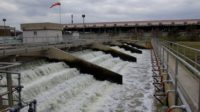A slate of public projects valued at hundreds of millions of dollars is being planned along the U.S.-Mexico border to prevent untreated wastewater from polluting the U.S. side of the Tijuana River valley and San Diego area beaches with trash, sediment and millions of gallons of raw sewage.
The bulk of the work is being planned by the U.S. Environmental Protection Agency (EPA), funded in part by $300 million from the United States-Mexico-Canada Agreement (USMCA ), though the agency estimates its total capital costs for the work will reach $627 million. The additional funding mechanisms have not yet been identified, according to EPA.
While those projects move through an environmental review process, short term mitigation of the water pollution problem will be undertaken by the U.S. Section of the International Boundary and Water Commission (IBWC). The agency, which deals with water issues along the U.S.-Mexico border, agreed to take action as part of a settlement earlier this month with the City of San Diego and several other area municipalities.
For most of the year, only a minute amount of water from the Tijuana River crosses the border. Major rain events can cause more than 100 million gallons of water, including a combination of treated and untreated wastewater, groundwater and stormwater, to flow into California per day, EPA says.
EPA’s plan—which it calls the “Comprehensive Infrastructure Solution”—includes eight projects, each targeting either treatment plants, pipe and pump infrastructure or contamination control before pollutants reach a body of water or treatment facility. Overall, EPA says its plan would result in a 76% reduction of days with the river flowing over the border and a 95% reduction in days of impaired water quality during the summer in Imperial Beach, where the Tijuana River meets the ocean.
Currently, a pump station diverts up to 25 million gallons of water per day from the Tijuana River through the IBWC’s South Bay International Wastewater Treatment Plant, a facility built in 1997 and upgraded in 2011. Under EPA's plan, that plant would be upgraded to have an average capacity of 35 million gallons per day, and an advanced primary treatment plant with a 60 mgd capacity would be built nearby. IBWC Commissioner Maria-Elena Giner says she aims for facility planning work to begin this year, followed by design next year and construction starting in 2024.
Some treated water would be rerouted for reuse under the EPA plan, instead of being discharged back into the river. Two other wastewater treatment plants would be built upstream off the Rodriguez Reservoir on the Mexican side. Sewers in Mexico would also be repaired to reduce leaks. Trash booms would be added in the river’s main channel on the U.S. side to stop trash and sediment from reaching further downriver. The plan also calls for the construction of a new San Antonio de los Buenos Treatment Plant in Tijuana with a daily capacity of 5 million gallons, which EPA says would eliminate sewage reaching the San Antonio de los Buenos Creek, which discharges into the Pacific Ocean.
EPA began its environmental review of the Comprehensive Infrastructure Solution in November. At the time, Radhika Fox, EPA assistant administrator for water, called the plan “a holistic water infrastructure strategy” that she said will address multiple facets of the region’s water challenges. The $300-million appropriated from USMCA will allow EPA to move forward, and the agency says senior officials will work with their Mexican counterparts and other U.S. agencies to explore cost sharing options, prioritize project order and coordinate on planning and design.
While those plans are in development, IBWC will get to work on some temporary mitigation projects under the terms of its recent settlement. Giner says the commission will begin installing five of seven new catch basins to be used for testing water quality in canyons feeding into the river over the next few weeks. The commission also plans to improve its maintenance of a flood control channel—Giner says about 1 million cu yd of sediment have accumulated, and extraordinary deferred maintenance will cost about $83 million to remove it. After that, routine annual maintenance is estimated at $5 million to remove an anticipated 60,000 cu yd of sediment each year.
IBWC will also propose construction of a temporary 6-ft-high, 20-ft-wide berm on the Mexican side of the Tijuana River basin, under the terms of the settlement. There is already one other berm, and Giner says adding a second will help prevent polluted water from flowing over the border until the new treatment plants are built. IBWC will provide Mexico with equipment for the work.
Chula Vista Mayor Mary Casillas Salas said the lawsuits were “a critical jumpstart” for addressing the pollution problem.
“With the case behind us, our focus now turns to working with our partners to ensure that federal pollution control infrastructure is constructed with the utmost expedience,” she said in a statement.





